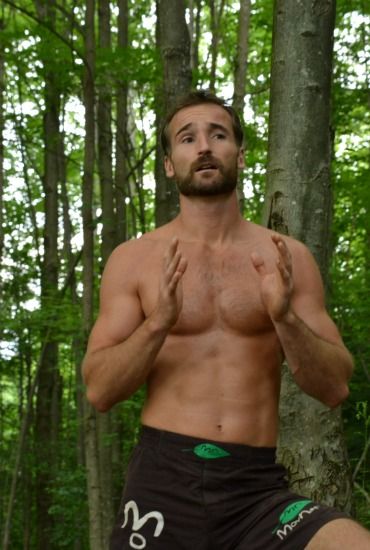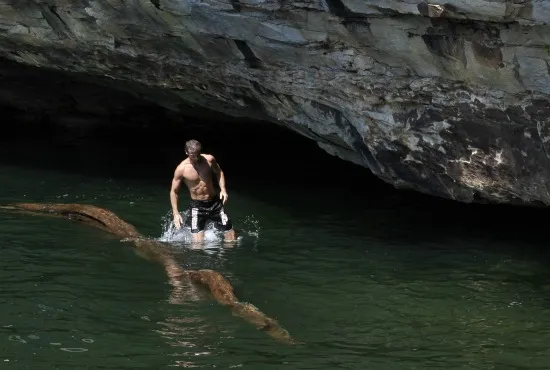Backwoods Workouts With the World’s Fittest Man
Erwan Le Corre can climb a tree as quickly as cat. He can also carrying logs, hoisting rocks, scaling cliffs, slogging through mud pits and wrestling
/https://tf-cmsv2-smithsonianmag-media.s3.amazonaws.com/filer/20120417110038Erwanlogcarry2SMALL.jpg)
Erwan Le Corre doesn’t care for treadmills or pumping iron. He gave up karate long ago and lost interest in playing soccer. Nor does yoga, yin to the yang of the weight room, hold much appeal for the 40-year-old Frenchman. Yet Le Corre is built like a track star and can climb a tree as quickly as cat. He is also is adept at carrying logs, tossing rocks, scaling cliffs, slogging through mud pits and wrestling.
In short, Le Corre is a master of his outdoor environment, and he has taught this seemingly bizarre set of skills to thousands of people. Le Corre is the brain behind an alternative fitness program, launched in 2009, that eschews the boring symmetry of weight machines and the vanity of commercial gyms and aims to teach participants the lost art and latent instincts of moving naturally. Called MovNat, Le Corre’s program consists of one-day to week-long outdoor courses around the world. During these camps, Le Corre himself sleeps, eats and plays alongside his students while teaching them the nutrition and the bodily motions that our species utilized in the Paleolithic era and, he says, has since forgotten.
Underlying the fun and games of MovNat is the notion that humans evolved as hunter-gatherers in an environment of dangers, obstacles and elusive foods—an environment that in modern times has all but vanished, replaced by asphalt, supermarkets, automobility and idleness. And though our world may have gone awry in recent centuries, we humans, Le Corre assures, have not changed at all.
“Deep inside of us, we’re still the same animal, and our bodies and minds still expect us to move like we did throughout our evolution,” Le Corre said during a phone interview. “We need to respect our biology, how we eat and sleep, who we are and how we move.”
MovNat’s calendar of programs includes two week-long sessions in Thailand (in January and February), three five-day summer sessions at Summersville Lake, in West Virginia, and one-day weekend workshops throughout the year in cities across North America and Europe. Lodging is provided at the multi-day camps. So are meals, in which nothing passes the lips that did not exist in the human diet prior to the advent of agriculture. This is what is popularly called the “Paleo diet,” though Le Corre prefers not to label his eating regimen in a way that suggests its relevance has come and gone. “I’m on a natural diet,” he explained. “The way I move and eat is not Paleolithic. It’s natural.” Alcohol, sugar, processed foods and snacking are firmly discouraged during MovNat camps, though meals, according to the MovNat website, are “copious.” In other words, it’s days of hard labor, hours of famine and then feasts to sate a caveman three times a day.
Le Corre, though an eccentric by some measures, seems to have struck a chord in many people. His program has become a great success among followers who, as Le Corre says, “are hungry for nature.” And so they pay up to nearly $3,000 to spend a week performing trail-running drills, log hopping, rock climbing, wrestling, swimming and tree climbing. Even crawling and rolling down grassy hillsides are components of a full-body MovNat workout.

Once called "the world's fittest man," exercise instructor Erwan Le Corre explains to students the Paleo principles behind his MovNat program and lifestyle. Photo courtesy of MovNat.
Dubious? Then just take a look at Le Corre, who has posed in magazines and been called “the world’s fittest man.” He didn’t gain that honor through a membership at the gym, which Le Corre notes is one of the only venues in Western society in which adults are encouraged anymore to exercise their bodies. Playgrounds and outdoor jungle gyms even forbid adults (other than parents) from engaging, and a typical job is one of day-long idleness.

“There are societal restrictions on how we move,” Le Corre told me. “It’s unhealthy. Look at kids around the world. They move the same way. They chase each other, jump, play. Why do adults become entirely sedentary so that we have to force ourselves to exercise on machines?”
Le Corre, of course, has much to gain by convincing the world to cancel gym memberships and come out to play in the sun, yet it’s hard to argue with his staid opinion of what he calls “commercialized fitness.” “(It’s) about repetitions and sets, and it’s very mathematical,” he said. “People find it boring.”
Even Yoga, says Le Corre, is too ingrained in tradition and religion to be fully aligned with human instincts and our natural movements. Plus, beyond the clouds of incense smoke, saluting the sun or posing like a warrior may be as useless as curling dumbbells is outside the weight room.
MovNat exercises, though, are about functionality, Le Corre says. They are supposed to be practical. No, not for running down antelope or fighting off scavenging hyenas. Those days are over. But occasions still arise when it pays to be fit—functionally fit, that is: We have buses to chase down and people to sometimes pull from flaming buildings. We may even need to carry a 200-pound log the length of a football field, or leap over a high fence, or climb swiftly up a tree, or jump off a rooftop and land unhurt. Sure, most of us could breeze by without much more than clicking a computer mouse—but I get Le Corre’s point, and I’m pretty much sold: We’ve graduated from the Paleolithic age, yet our world remains an obstacle course. Why not get used to it?
Tapping the Paleo Revoltion
MovNat is not the only trend of backstepping away from commercialized fitness and nutrition, and toward our Paleo beginnings. Trail running with bare feet (or with those funny-looking “toe socks“) may never have been more popular, largely due to the hit book Born to Run, in which author Christopher McDougall tells how human hunters evolved as barefooted trail runners before putting on shoes and becoming farmers.
In urban settings, outdoor fitness classes and boot camps seem to be on the rise, like the Urban Gym program developed by Rat Race Adventure in London.
More and more joggers and cyclists, it now seems by my own observations, are using outdoor pull-up and sit-up stations.
And the increasingly popular Paleo diet is a strong indicator that people are craving the supposedly gluten-free days before agriculture, when we moved as nomads, hunting for meat and foraging for plants.

/https://tf-cmsv2-smithsonianmag-media.s3.amazonaws.com/accounts/headshot/Off-Road-alastair-bland-240.jpg)
/https://tf-cmsv2-smithsonianmag-media.s3.amazonaws.com/accounts/headshot/Off-Road-alastair-bland-240.jpg)